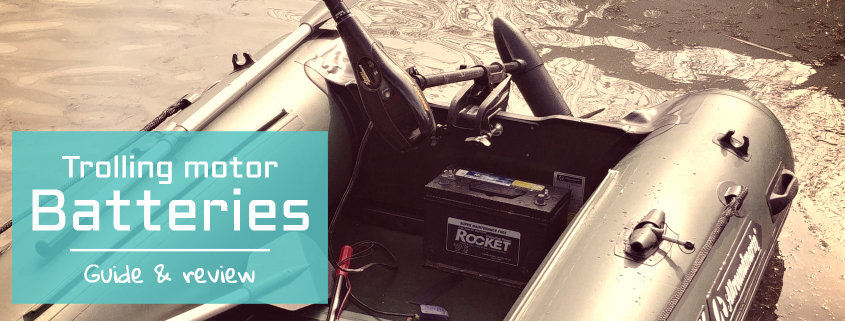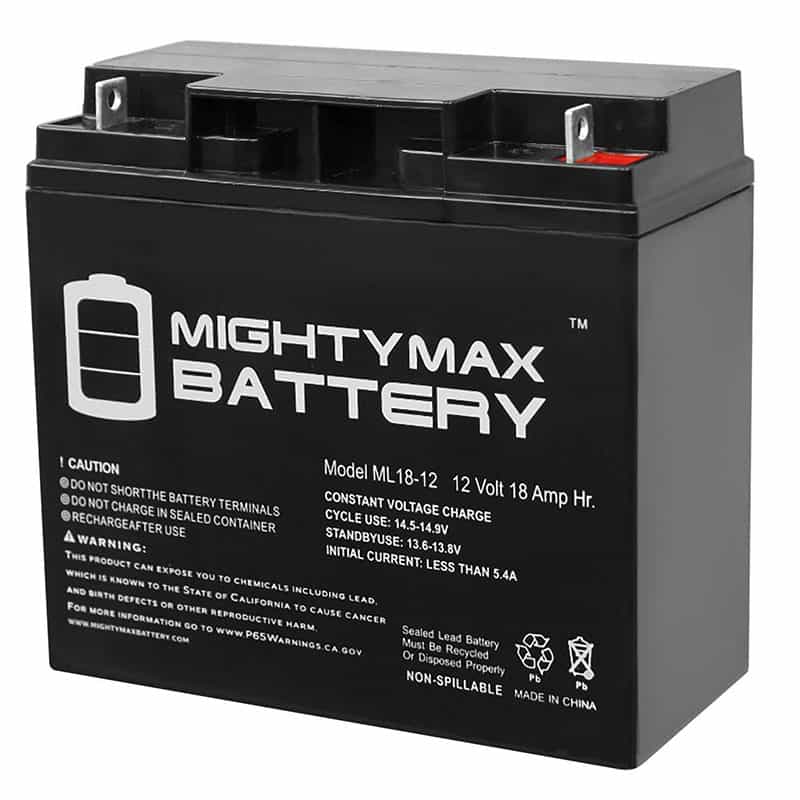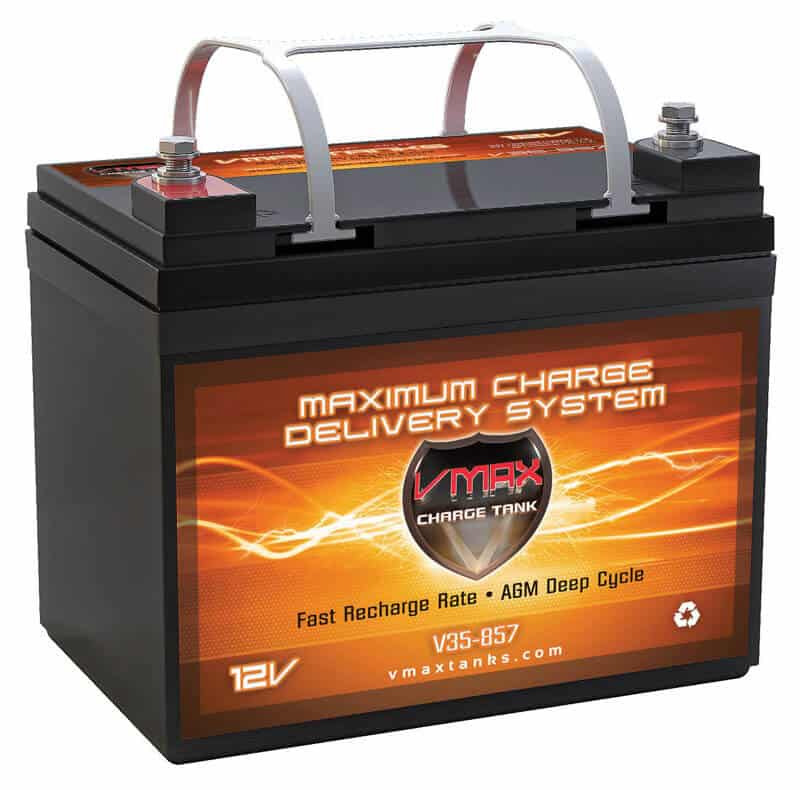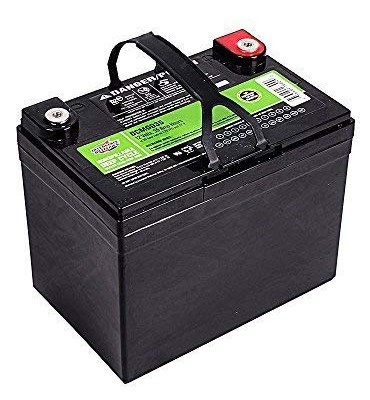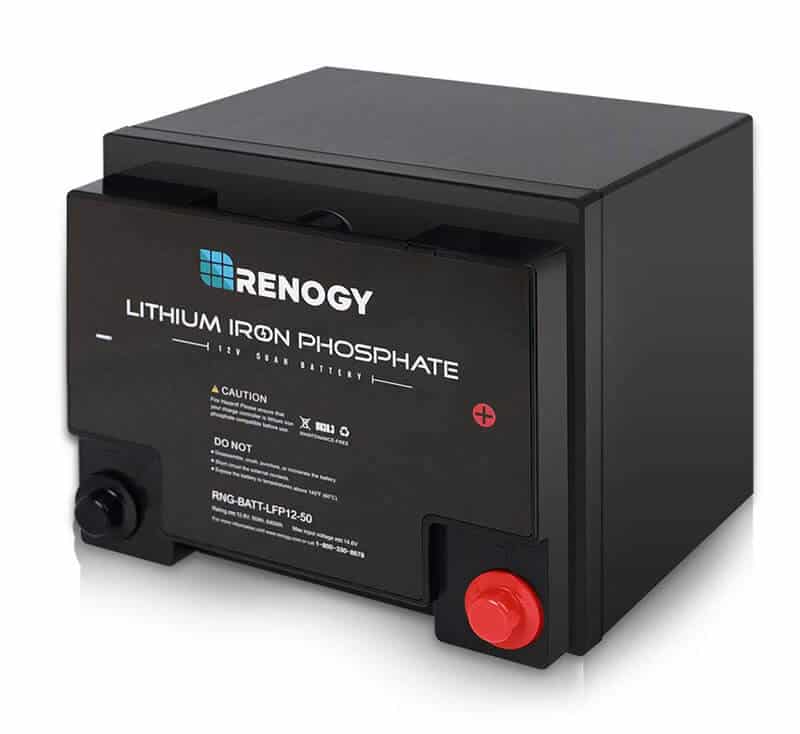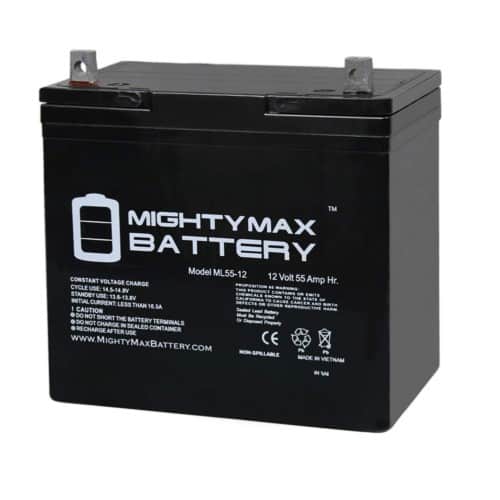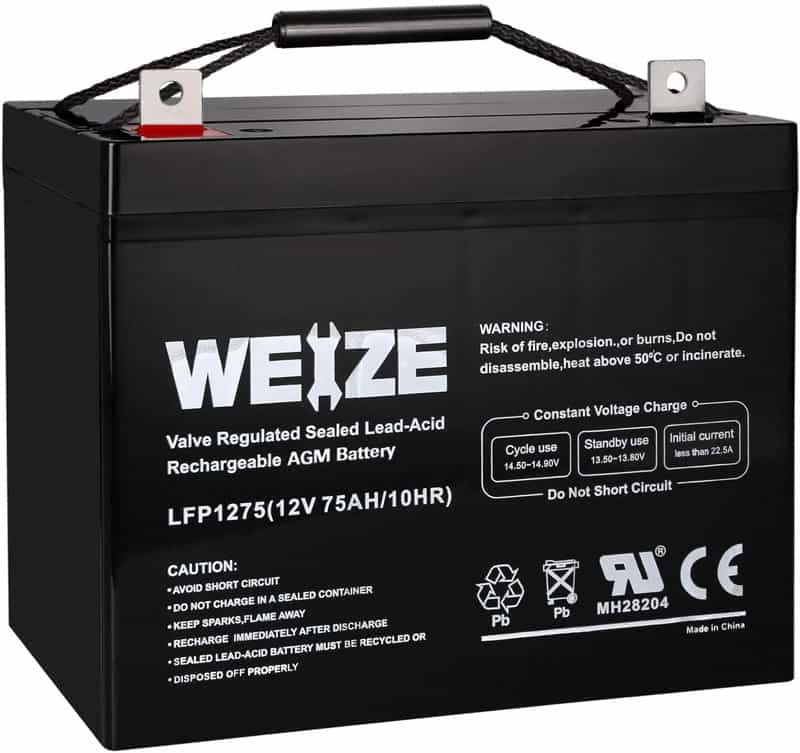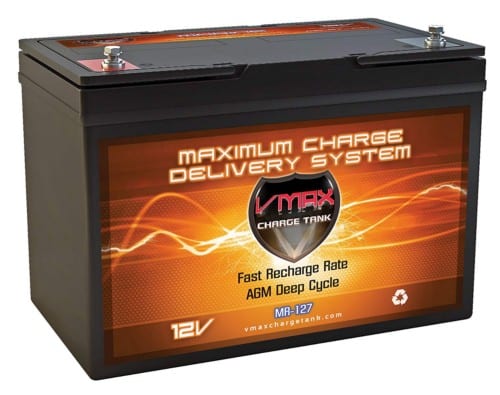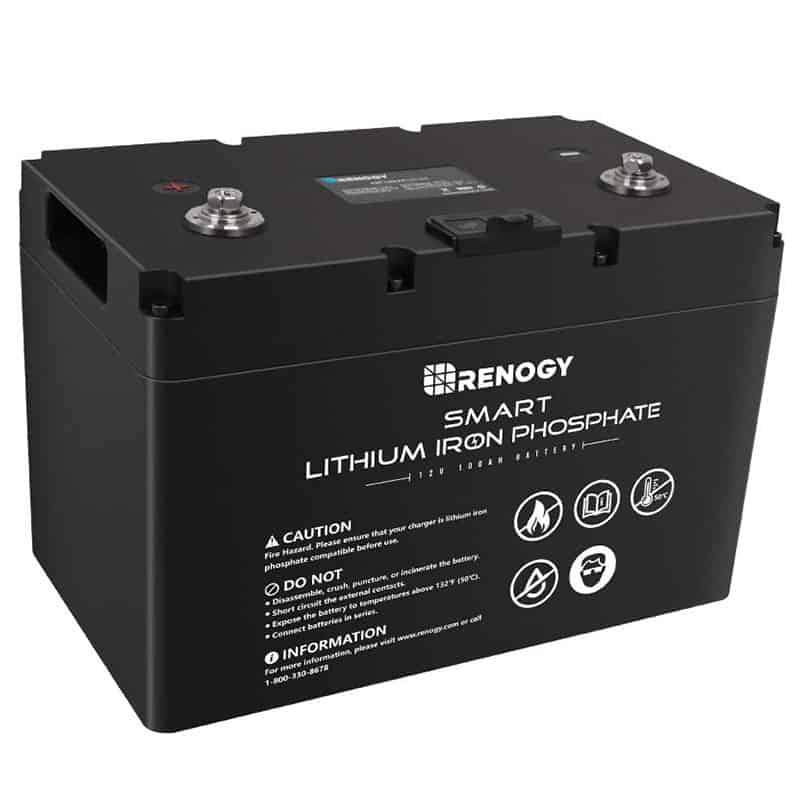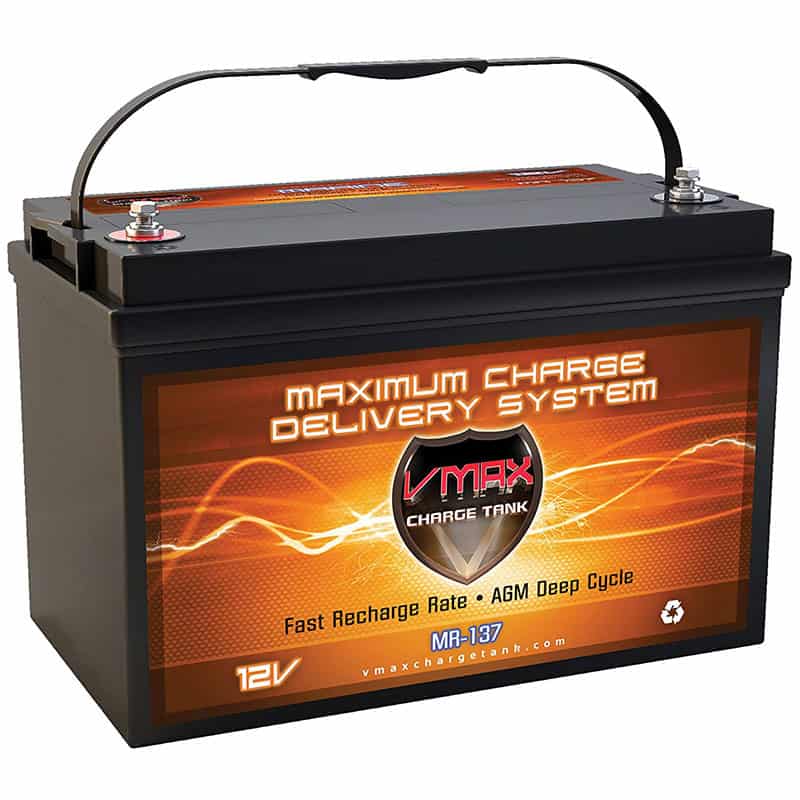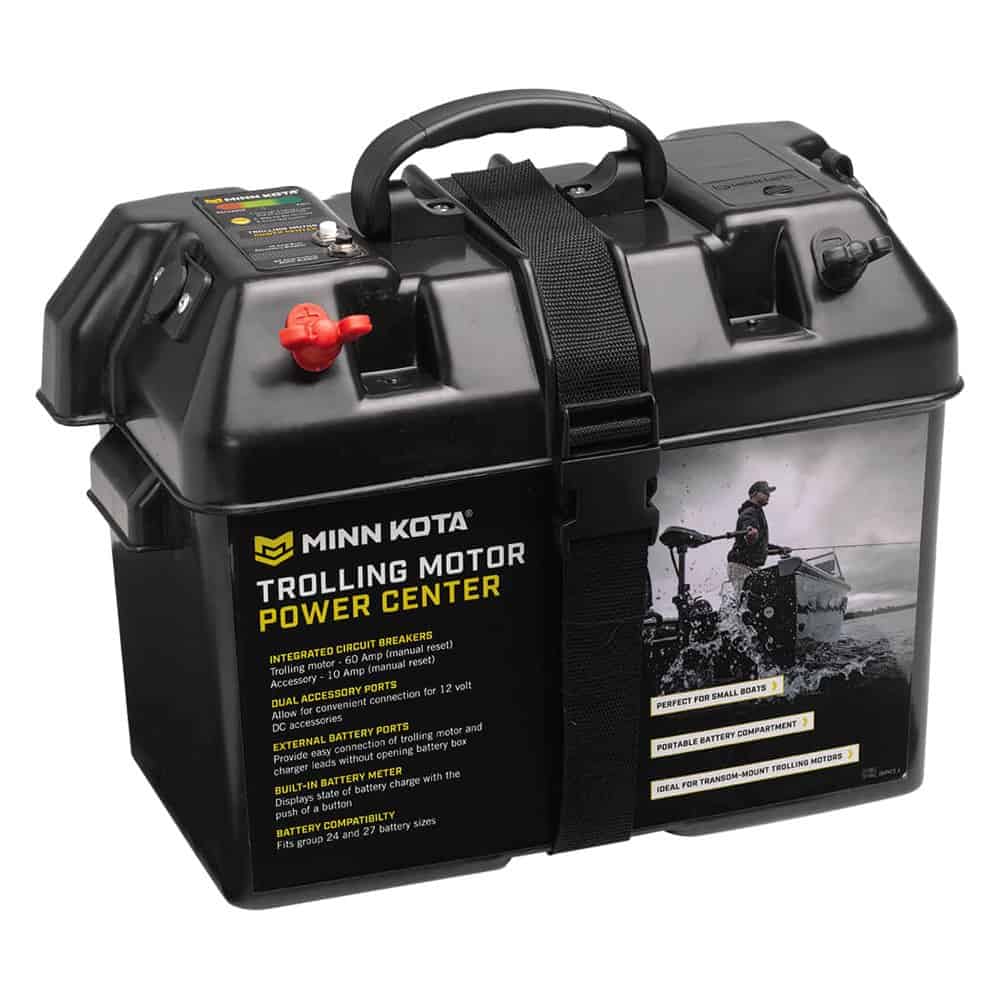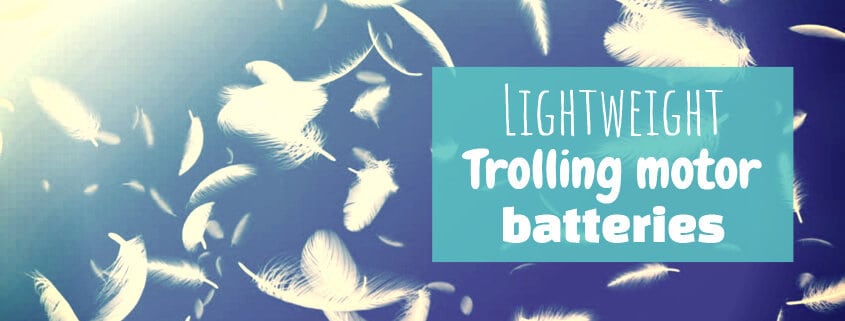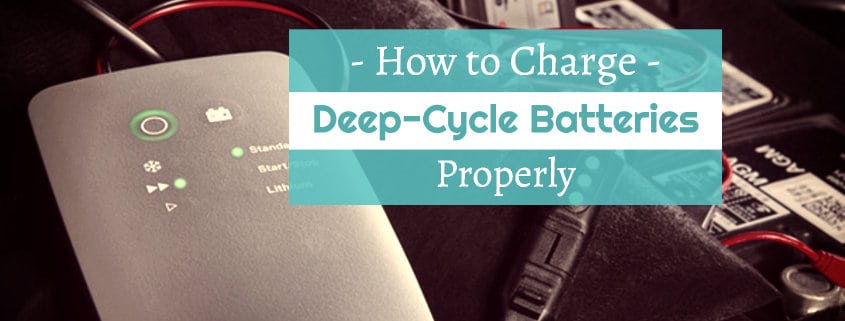Electric trolling motors run on marine deep-cycle batteries. You probably knew that already, but it’s not as simple as taking any battery from a shelf.
To make sure the battery you choose is compatible with your motor, expectations and intended usage, there are several things you need to take into consideration:
- capacity
- voltage
- weight and size
- deep cycle or cold cranking
- maintenance
- build technology
In this review of the top trolling motor batteries of 2024, I’ll show you the best ones and teach you how to choose the most suitable battery for your specific needs.
Let’s start!
Contents
Best deep-cycle trolling motor batteries in 2024
Here are the most dependable deep-cycle marine-grade batteries to power your trolling motor. The batteries are ordered based on capacity.
You will find the details and reviews of each one below the summary table.
| Name | Capacity (Ah) | Technology | Weight (lbs) | Price |
|---|---|---|---|---|
| MIGHTY MAX ML18-12 | 18 | AGM | 12 | Details |
| VMAX V35-857 | 35 | AGM | 25 | Details |
| Interstate 35 | 35 | AGM | 23 | Details |
| Renogy 50Ah | 50 | Lithium | 15 | Details |
| VMAX MR86-50 | 50 | AGM | 32 | Details |
| Mighty Max 12V 55Ah | 55 | AGM | 39 | Details |
| Weize 12V 75AH | 75 | AGM | 45 | Details |
| VMAX MR127 | 100 | AGM | 69 | Details |
| Renogy 100Ah | 100 | Lithium | 26 | Details |
| VMAX MR137 | 120 | AGM | 75 | Details |
Mighty Max ML18-12
Mighty Max is an established battery brand. Their deep cycle AGM batteries have wide operating temperatures, are leak-free, and require no maintenance.
The small 18 Ah capacity of this battery is suitable for small trolling motors.
- Voltage: 12 V
- Capacity: 18 Ah
- Technology: AGM
- Size: 7.13″ x 3.01″ x 6.57″
- Weight: 11.90 lbs
- Warranty: 1 year
- Rating: 4.6 of 5
VMAX V35-857
VMAX batteries are very high quality batteries, so they are more expensive their competition. They generally have a longer life span, and they can recover from deep discharges. If you will not use your battery often, I would recommend the brand.
The 35 Ah isn’t a lot, but it’ll get you from A to B.
- Voltage: 12 V
- Capacity: 35 Ah
- Technology: AGM
- Size: 7.7″ x 5″ x 6.1″
- Weight: 25 lbs
- Warranty: 1 year
- Rating: 4.2 of 5
Interstate 35
The Interstate 35 Ah battery is a direct competitor to the VMAX above. It is about $20 cheaper.
It will do what it needs to, but will probably not be as reliable in the long run.
- Voltage: 12 V
- Capacity: 35 Ah
- Technology: AGM
- Size: 7.68″ x 5.16″ x 6.14″
- Weight: 23.10 lbs
- Warranty: 1 year
- Rating: 4.3 of 5
Renogy 50 Ah
This Renogy deep cycle battery uses Lithium Iron Phosphate to store energy. It is much more efficient, has more charging cycles, and weighs much less than comparable AGM batteries.
The trade off is that it is much more expensive.
- Voltage: 12 V
- Capacity: 50 Ah
- Technology: Lithium
- Size: 7.75″ x 6.53″ x 6.73″
- Weight: 14.77 lbs
- Warranty: 5-year prorated warranty
- Rating: 4.2 of 5
VMAX MR86-50
This 50 Ah deep cycle battery is a solid choice to power your trolling motor.
It is much heavier than the Lithium one from Renogy, but costs 1/3 of its price
- Voltage: 12 V
- Capacity: 50 Ah
- Technology: AGM
- Size: 10.02″ x 6.65″ x 8.94″
- Weight: 32 lbs
- Warranty: 1 year
- Rating: 4.9 of 5
Mighty Max 12V 55Ah
This 55 Ah Mighty Max battery has about the same capacity as the VMAX 50 Ah, but its size is totally different. This one is taller but skinnier, the VMAX is more box shaped.
And of course, the MIghty Max is a little cheaper.
- Voltage: 12 V
- Capacity: 55 Ah
- Technology: AGM
- Size: 9.02″ x 5.43″ x 9.13″
- Weight: 38.58 lbs
- Warranty: 1 year
- Rating: 4.2 of 5
Weize 75 Ah
This 75 Ah AGM battery is a good compromise if you think a 50 is too small, but the 100 is too large. It comes at a great price as well, highly recommended.
- Voltage: 12 V
- Capacity: 75 Ah
- Technology: AGM
- Size: 10.02″ x 6.65″ x 8.94″
- Weight: 46 lbs
- Warranty: 1 year
- Rating: 4.3 of 5
VMAX MR127-100
We enter the realm of high capacity batteries with this 100 Ah VMAX.
As all batteries made by the company, the MR127 is highly dependable and will provide hours of trolling on a single charge. The only negative is its weight.
- Voltage: 12 V
- Capacity: 100 Ah
- Technology: AGM
- Size: 12.1″ x 6.7″ x 8.2″
- Weight: 68 lbs
- Warranty: 1 year
- Rating: 4.4 of 5
Renogy 100Ah
This is another Lithium battery from Renogy. As you already know, it is much lighter than a comparable 100 Ah AGM battery, but is more expensive.
If you use your boat every day though, this would be my recommendation. You will get much more usage out of a Lithium battery, around 4000 cycles vs the 500 cycles of AGM batteries.
- Voltage: 12 V
- Capacity: 100 Ah
- Technology: Lithium
- Size: 15″ x 11.5″ x 10″
- Weight: 26 lbs
- Warranty: 5-year prorated warranty
- Rating: 5 of 5
VMAX MR137-120
The 120 Ah VMAX is a true heavy hitter. Literally. It weighs 75 pounds, so make sure your boat can support it. and you have a way to carry it
All AGM batteries from the brand are heavy duty and maintenance free. Other than charging it correctly, you never have to worry about it.
- Voltage: 12 V
- Capacity: 120 Ah
- Technology: AGM
- Size: 13″ x 6.8″ x 8.8″
- Weight: 75 lbs
- Warranty: 1 year
- Rating: 4.6 of 5
How to pick the right trolling motor battery
Before getting into my recommendations on specific batteries, let’s run through the things you need to know before you can choose a battery for your electric trolling motor.
Deep cycle vs cold cranking. What’s the difference?
To run a trolling motor, you need to have a battery that provides a steady source of power. So called deep cycle marine batteries are designed to do just that.
Deep cycle batteries can discharge their total power capacity over a long time, nice and slow, in a steady manner.
In contrast, cold cranking batteries are designed to crank and start outboard engines by discharging a lot of power quickly. They are basically motor starting batteries similar to car batteries. By design, cold cranking batteries cannot power a trolling motor.
You can also get dual-purpose batteries, which have both technologies integrated into a single battery shell. You would only use these on larger boats, where you need to crank the engine, and also provide power to various electrical appliances onboard.
But to run an electric trolling motor, you need a deep-cycle marine battery.
Type of battery
Marine-grade batteries are made of chemicals inside the shell. There are 4 main types of batteries, you can read more about how each works here if you like.
Flooded lead acidGel- Absorbed Glass Mat (AGM)
- Lithium
I won’t even get into flooded or gel batteries. That is old technology, which I wouldn’t use. Nowadays, these batteries are used less and less because they can sometimes pose a danger when mishandled. They are highly sensitive to cold temperatures and have a tendency to release flammable gasses. When stored and misused, they also tend to spill acid. Not recommended.
AGM batteries are the most popular battery types used to power trolling motors. They are dependable, require no maintenance, are spill-free, and have better shock tolerance. For these reasons, AGM batteries are becoming a favorite pick among boaters.
Lithium batteries are an emerging trend in deep cycle marine batteries. They are much more efficient, longer lasting, and incredibly light compared to AGM batteries of the same capacity.
The only problem is that they cost 4-5x more.
This table will help you compare the pros and cons of AGM vs Lithium deep-cycle batteries to be used with trolling motors.
AGM battery
Lithium battery
In short, Lithium batteries:
- last longer
- have more efficient use of battery capacity
- run longer
- charge faster
- have a lower self-discharge rate
- are lighter
- are more expensive
If you use your trolling motor every day and have the budget, you should get a Lithium battery.
If not, you will be OK with an AGM.
Amperage hour rating (Ah)
The Amp hours rating (abbreviated Ah) is a unit of measure that tells you how much electricity the battery can store.
The larger the Ah of a battery, the more electricity it can store.
As you might guess, this is one of the most important factors you need to consider when choosing a deep-cycle marine battery. The battery capacity you choose should be enough for whatever activity you will use it for.
How long will a deep-cycle marine battery run a trolling motor?
A marine battery will be able to power a trolling motor for anywhere from 30 minutes to 20 hours, depending on the battery capacity and how you use the trolling motor.
Here is a useful table to help you plot how much run time you can expect to get from batteries of differing Ah.
| Trolling motor thrust | Amps drawn at | 35Ah battery run time (hours) at | 50Ah battery run time (hours) at | 100Ah battery run time (hours) at | ||||||||
| min speed | med speed | max speed | min speed | med speed | max speed | min speed | med speed | max speed | min speed | med speed | max speed | |
| 30 lbs | 5 | 15 | 30 | 5.6 | 1.9 | 0.9 | 8 | 2.7 | 1.3 | 16 | 5.3 | 2.7 |
| 55 lbs | 5 | 30 | 50 | 5.6 | 0.9 | 0.6 | 8 | 1.3 | 0.8 | 16 | 2.7 | 1.6 |
The above are theoretical numbers, based on a few things:
- Uniform water & weather conditions (unlikely)
- Leaving 20% charge in the battery (you should never drain it completely)
So, should you get a 200 Ah battery so you can troll around for 2 days at max throttle? Probably not. There is a trade-off in size, weight, and price.
For most boaters using a trolling motor, the sweet spot will be a battery between 50-100 Ah.
But if you plan on doing a lot of fishing, you could benefit from a battery with more amp hours.
Weight and size of the battery
The weight of your battery will be an important consideration, especially if you plan on using it in an inflatable boat or kayak.
We’ve already established that deep-cycle AGM and Lithium batteries are the way to go when it comes to use with trolling motors. Depending on which type you get, the weight and size of the battery will be very different.
Lithium batteries are exceptionally light when compared to AGM batteries, their size is similar though. As you already know, they are much more expensive.
Here is a quick table comparing AGM and Lithium batteries of the same capacity.
| Battery | Type | Capacity | Weight | Size |
|---|---|---|---|---|
| VMAX MR86-50 | AGM | 50 Ah | 45.5 lb (ca. 21 kg) | 7.8″ x 6.6″ x 6.7″ |
| RENOGY 50 AH | Lithium | 50 Ah | 14.8 lb (ca. 7 kg) | 7.7″ x 6.5″ x 6.7″ |
| VMAX MR127 | AGM | 100 Ah | 68 lb (ca. 31 kg) | 12.1″ x 6.7″ x 8.2″ |
| MIGHTY MAX BATTERY 12V 100AH | Lithium | 100 Ah | 30 lb (ca. 14 kg) | 13″ x 6.8″ x 8.7″ |
If you have a decent size inflatable boat and don’t plan on taking 6 people in it, you’ll have room for the larger AGM battery. But if you are in a kayak where weight really matters, you might consider a more expensive Lithium battery.
You should also keep in mind that you may need to lug a 68 lb brick from your car to the boat. Not an easy job without a dolly or some form of help.
Here is a post I wrote on small and light marine batteries if that sounds like you.
Battery voltage: 12, 24, 36?
The trolling motor you will pair your battery with will have a voltage rating. It will be either 12V, 24V or 36V. This motor rating is what determines how much voltage output you need from your batteries.
Most batteries have an output of 12V, which is generally enough for trolling motors with 55 lbs of thrust or less.
But motors with more than 60 lbs of thrust will require 24V output from the battery that powers them. The strongest ones need 36V!
How do you get 24V battery output for such motors?
The best way is to wire two 12V batteries in series. This combines the voltage of the two 12V batteries, so that they output a total of 24V.
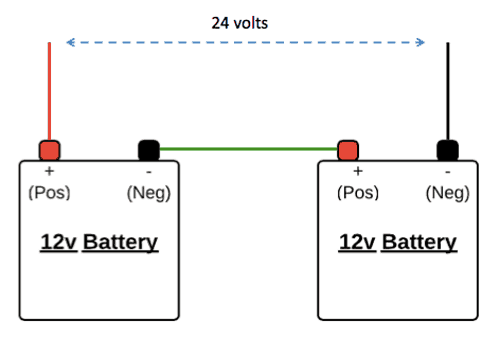
Need 36V? Wire another 12V battery into the series. And make sure you don’t wire them in parallel, because that just combines their battery life, without increasing their output.
Here is a video on how to wire marine batteries in series.
Just so you know, you can also buy 24V batteries, but a single 24V battery will cost double what two 12V batteries cost.
Marine battery maintenance
Good news! If you get an AGM or a Lithium battery, they do not require any special maintenance as gel and flooded batteries did .
Of course, there are ways to considerably extend (or shorten) the life of your battery, which I will talk about later in the article.
What is the “marine battery group size”?
The marine battery group size is a sizing convention set by the Battery Council. The sizes simply refer to the physical size of the battery.
The battery group size is important when looking for a replacement battery, which needs to fit perfectly into the compartment it needs to be in. These are called drop-in replacement batteries.
If you have a smart battery box like the Newport Vessels Smart Power Center, the maximum size of the battery will be specified. This box can fit a battery with group size 24 & 27.
You can get more info on the most popular marine battery group sizes in this guide.
Battery box/power center. Do you need one?
When you use a marine battery to power your trolling motor, you will have to decide where you will place the battery itself.
If you’re on a traditional fiberglass boat, you will probably have a compartment to store it in.
But on inflatable boats, be it a raft, like the Intex Excursion 5, or a dinghy like the Sea Eagle 126SR, you will have to put the battery right under the motor at the transom.
Leaving it out in the open and hooking it up with the trolling motor is possible, it will work just fine. AGM and Lithium batteries are waterproof. I once dropped one into the lake, fished it out, and it worked flawlessly after drying.
But a much safer and practical alternative is placing the marine battery into a power center. This is especially important if you will have kids in the boat.
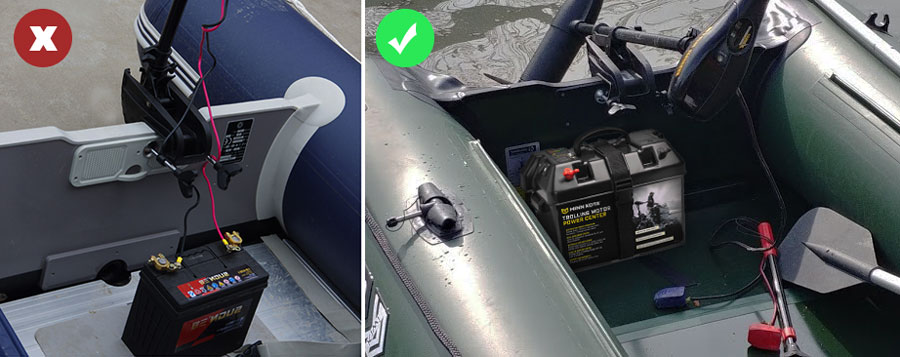
I now use this MinnKota power center. It keeps the battery and my kids protected, and has useful features:
- Two 12-volt accessory plugs – Car cigar lighter style, so you can bring any electrical appliance you need (phone charger, etc.)
- 2 manual reset circuit breakers – 1 for the motor and 1 for the accessory plugs. This is cool since you don’t need to but the circuit breakers separately and hook them up.
- Built-in battery meter – In case your motor doesn’t show you your battery levels.
- Screw-in battery terminals – The simplest way to hook your cables up.
I highly recommend you get this power center if you will use your battery on an inflatable boat.
Proper marine battery maintenance
Paying attention to how you use, charge and store your battery can really extend its life cycle.
Here are a few important marine battery maintenance tips.
- Secure the battery somehow, so it doesn’t bang around in rough water.
- A battery power center can help protect a battery out on the water.
- Check the battery terminal connections often, and remove any corrosion.
- After use, give your battery a full charge.
- Fast charging cycles with high voltage are to be avoided.
- Smart multi-stage chargers are the best types of chargers. They regulate the charge and current based on what the battery needs at any given charge level, they regulate temperature.
- Never store an empty battery after use without charging. Always give it a full charge after you use it.
- Avoid storing batteries for a long time. You need to charge them every 6 months if not in use. Some smart chargers can be left plugged in, and they will trickle power to the battery as needed.
- Don’t store batteries in too hot or cold environments.
If there is 1 thing that can shorten or lengthen the life of a battery, it is the way you charge it. Here is how to do it properly.
Frequently asked questions
There are a lot of typical questions beginner boaters have about trolling motor batteries. Here are the answers to the most common ones.
What is the difference between a marine battery and a car battery?
Car batteries are different from marine batteries that can power trolling motors. Car batteries are cranking batteries designed to start car engines. They output a lot of power over a short amount of time, and are recharged by the alternator while the engine is running. The plates inside car batteries are thinner, so they produce less power than marine batteries.
You should never use a cranking battery to power a trolling motor, as it will overheat and fail.
Marine batteries are different. When you need to use a battery on a boat to power a trolling motor, you need a deep-cycle marine battery. These types of batteries are designed to output steady power over a long period of time, which is what is needed to power a trolling motor.
You can also get dual purpose marine batteries. These have cold-cranking and deep-cycle functionality built into the same battery shell. You can use them to start an outboard engine, and to power electrical appliances on the boat if the engine is turned off.
The term “marine battery” signifies batteries developed for use on boats. You still need to know whether you need a deep cycle marine battery, a cold cranking marine battery, or a dual purpose marine battery.
Can you use a deep cycle battery to start an engine?
Yes you can, but they are not capable of producing as much power as a cranking battery. You should get a marine-grade cranking battery to start your engine.
How long do marine batteries last?
If you take care of your battery by following maintenance best practices, your battery should last 3-5 years under normal use.
Beside proper maintenance, the number of times a battery is charged also affects its longevity. AGM batteries have 300-500 charge cycles in them, while Lithium marine batteries have a lifespan of around 5000 cycles.

